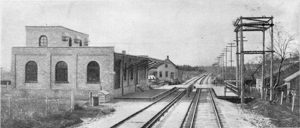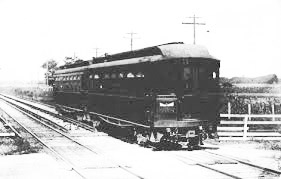
 Jack Jones remembers when a train fare was around a dime, and that the Chicago Aurora & Elgin train went all the way to Wells Street in Chicago, where one could then take an el train to the Loop.
Jack Jones remembers when a train fare was around a dime, and that the Chicago Aurora & Elgin train went all the way to Wells Street in Chicago, where one could then take an el train to the Loop.
The era of that third-rail train sprouting from the far west and funneling in Wheaton to carry travelers to Chicago is long gone, but the Lombard Historic Preservation Commission is giving it some new life.
That CA&E line is now the Illinois Prairie Path, and the commission has been working for a number of years to get some recognition for its local significance, according to commission President Rita Schneider.
She credits Jones for coming up with the idea to place signs along the train stops. He said simply how he thought it would be a nice idea “to tell them [path users] why it came about.”
Greatthirdrail.org, which is dedicated to the now-defunct railroad line, shows that a “syndicate” called Everett-Moore incorporated the Aurora and Chicago Railway Company and the Elgin and Chicago Railway Company in 1899, after which the Chicago, Wheaton and Aurora Railroad Company was incorporated by a competing syndicate named Pomeroy-Mandelbaum.
Not long after, the Aurora, Wheaton and Chicago Railway Company is incorporated into the Everett-Moore syndicate.
In the early 1900s, municipalities east of Wheaton began granting franchises to the various railway companies that had formed, and trains began running in the early 1900s—such as the Batavia branch in 1902 and the Elgin branch in 1903.
According to greatthirdrailorg, Lombard’s Main Street, Westmore Avenue and Stewart Avenue stops opened in 1902, while Green Valley (originally called the West Lombard Station near Brewster) opened in 1904.
Eventually a number of train lines were consolidated until in 1922 the Third Rail Division of the Aurora Elgin & Chicago Railroad was reorganized as the Chicago Aurora & Elgin railroad.
According to information from the Lombard Historic Preservation Commission, the railroad had 33 miles of track, powered by an electrified third rail, and service to the Loop opened in 1905.
The Main Street Station contained one of the railroad’s first electrical substations that powered the third rail.
The Westmore Station was a “flag stop” and a wooden station was built during the 1930s when Lombard’s population began to expand. There was no ticket agent but a nearby hardware store owner became an authorized ticket agent.
The Green Valley Station was so named after a book written by Lombard author Katherine Reynolds. It had two small wooden shelters on either side of Brewster Avenue. This stop had no ticket agent and was also a flag stop, served by local trains.
The CA&E could transport as many as 100,000 passengers each day, according to the commission, but was losing $2,000 a day.
Passenger service came to an end on July 3, 1957; freight service was suspended June 10, 1959; and July 6, 1961, the CA&E was abandoned at 5 p.m., according to greatthirdrail.org.
The historic preservation commission notes that the DuPage County Highway Commission purchased the abandoned track bed in 1965, giving Lombard a 2.75-mile strip of the Illinois Prairie Path.
Jones, who grew up on View Street, just east of Main Street and was a former Lombard fire chief, remembers, “You could ride out to Wheaton,” adding that he would take the CA&E to Glen Ellyn, where he worked as a caddy.
However, he took the Chicago and Northwestern line into Chicago during his last years of high school because it stopped closer to his job.
He also recounted how “My grandfather used to take it [CA&E] to come out for a visit from Chicago.”
“It was a very popular mode of transportation,” Jones recalled, because it came by more frequently and was a faster commute. He also remembers the nickname “Cannonball,” because some trains hit speeds of 70 mph.
He described how at the Stewart and Brewster stops, someone wanting to board the train would pull a rope that would lower an arm, signaling to the engineer that someone wanted to get on the train.
In the early days, though, there were no gates to stop vehicles from crossing the tracks, such as on Main Street, although he remembers there being a stoplight there.
Jones and others who lived in Lombard in 1943 also remember how dangerous the third rail could be, saying, “It was kind of a knowledge you shouldn’t touch it.”
A young boy named Harvey Rechsteiner was crossing the tracks near Brewster and slipped.
A slightly older boy, Jerry Curtis, came to his rescue by grabbing onto the back of Rechsteiner’s jacket, yanking him away from certain electrocution. Rechsteiner suffered burns and was hospitalized for his injuries.
Schneider said the idea of commemorating Lombard’s portion of the CA&E was brought about because “The Chicago Aurora and Elgin was really a vital part of Lombard.”
“The signs are based on the historical significance of the Chicago Aurora and Elgin. There’s quite a bit to say about the railroad itself,” she added.
When Jones planted the seeds of an idea to place signage at the four stops, the commission president remembers, “We looked at each other and said, ‘Boy, that’s really a good idea.’ ”
“We started researching what we would have to do … laws and regulations we’d have to put up with,” she continued.
That meant also working with the DuPage County Prairie Path Authority and looking into sign businesses, Schneider added.
As it turned out, “We had to go outside of Lombard, actually,” such as to the Illinois Railway Museum in Union, and the Villa Park Historical Society, she mentioned.
“There were all kinds of obstacles,” Schneider recalled, from getting permission to use materials to locating the owner of a “great photo” of the CA&E.
Eileen Mueller, head of the Local Landmarks Committee, echoed Schneider in saying that the process took a number of years to complete—researching and looking for photos to include on the signs.
“It took us a long time,” she said with a chuckle, adding that the researchers faced some challenges, included getting permission to reprint items for the signs.
She commended Carl Lantz from the Strayhorn Library at the Illinois Railway Museum for providing information for the research, adding that the Village of Lombard was also very helpful.
Members of the Local Landmarks Committee who also worked on the project include Tom Fetters, Jones, Marcy Novak and Jennifer Henaghan.
Preservation commission members include Richard Anstee, Lyn Myers, Brigitte O’Brien, Patricia Poskocil, Stephanie Zabela and village staff liaison Tami Urish.
Other contributors to the sign project include Jean Cooper and Sarah Richardt from the Lombard Historical Society; the Illinois Prairie Path Board; Carl Goldsmith from public works; the village’s division of planning service and department of community development; and Serge Ruffolo, Western Remac Inc.
Schneider and Mueller also commended Randall Bullen of Randall Bullen Photography in Lombard, who worked to enhance the photo images.
“He cleaned up the pictures. They really came out nice,” Mueller praised.
Now that the work is behind them and having signage installed is on the horizon, “It’s just a thrill to know we have this done,” Mueller said. “I’m delighted we have accomplished it.”
“I love anything that keeps history in Lombard,” Mueller emphasized. “The fact that it [CA&E] went through Lombard …”
The Local Landmarks Committee will hold a recognition ceremony Friday, April 28, at 10 a.m. at the southeast corner of Main Street and the Illinois Prairie Path, followed by light refreshments at the Carriage House behind the Victorian Cottage.
For more information about the CA&E Railway, visit www.villageoflombard.org/CAERail.
